ABOUT FIREFAQS
First Things First
As you read this section of the web site, please keep these three things in mind:
1) Some people will read this section and may leave thinking that I am focused on talking extensively about my career. That's not my intention.
2) My intention is to get you thinking about a fire service career or a desire to be a skilled fire investigator or competent fire consultant or qualified fire service leader or find answers to fire-related questions. I want to stimulate your thinking and boost your desire to acquire knowledge, improve your skills and strengthen your abilities.
3) My intention in this segment is to provide information about my background so you can decide if you believe I am qualified to express the ideas, opinions and thoughts you will read here.
I routinely offer assistance to prospective firefighters and anyone else that is looking for information that will enable them to help people live better and safer lives. Sometimes, I provide information to firefighters that are seeking greater responsibility through promotional opportunities. Sometimes, I help people that are dealing with fires or explosions that have already occurred. I provide a lot of information at no charge - especially to prospective firefighters and firefighters wanting to improve their job skills or pursue promotional opportunities. In some instances, I work as a fire consultant and charge a fee for the work I do.
We each form perceptions based on our perspectives, and my perceptions are exclusively mine. Therefore, please don't take offense at what I write here. From my perspective, I am focused on hoping that I can use this web site to help people live better and safer lives. This a predominant theme of mine. You may see it often if you stick around or return periodically. If that means that I focus on helping prospective firefighters become actual firefighters, then one of my objectives has been reached. There are other purposes for this web site. Hopefully, the various segments will be useful to those of you that are interested in the information that I share here.
Whenever I can, I speak to students and other prospective firefighters about the importance of having interested, capable and qualified candidates for fire service careers. I have been an elementary school volunteer since I retired. Students need strong reading and math skills if they are to become productive workers, managers and leaders when they are out of school. I have no trouble maintaining an active lifestyle because I try to concentrate on helping others. At this stage of my life, I am often more able to serve as a de facto recruiter and motivator of prospective firefighters than I am able to motivate folks that have been in the fire service for a long time. This segment gives you an overview of my career and how I acquired the information, knowledge and opinions that I am sharing here.
In the following paragraphs, you will see that I have shared quite a bit of information about my career and several personal decisions as they relate to my fire service career. Ordinarily, I don't write much about my personal life. However, those of you that work for fire departments or allied agencies may benefit from something that I share here. If that occurs, then my taking the time to write this will be worthwhile.
Please keep in mind that what you will see in these web pages has been influenced by my opinions that evolved over the course of my entire career and are tempered by my post-career moments.
Overview
I benefited during my career from endless opportunities to meet and learn from highly qualified personnel, untold chances to work with extremely personable and skilled mentors and leaders and from a wide variety of job assignments. At times, I felt my brain had evolved into being a large sponge. As we each know, sponges can become saturated if they aren't squeezed to enable them to hold more. So, I found ways during my career to mentally "circulate and file" knowledge and experience so that I could make more room for learning.
I had personal motivation to learn as much as I could: I didn't want to die or be badly injured during my career. When I became responsible for the well being of others, I accepted responsibility for seeing that they didn't die or become badly injured. One way that I could help avoid death and injury was through acquiring knowledge, skills and abilities that helped me become and remain a proficient firefighter.
My Career
My fire service career began in 1963. Fifty years later, I retired as a fire chief on my wife's birthday in 2013. That's an unusual birthday present, but that's what I wanted to do. My wife's support during my career was always present, and it will forever be appreciated.
To better understand me and to help you determine whether you want to listen to my advice, recommendations and suggestions, I am going to share my fire service story. If you become a firefighter, you should be prepared to share your story. One of the most frequently asked questions during my career has been this one: "Why did you become a firefighter?"
When I was four years old, I told my parents that I wanted to be a "garbage truck" driver when I grew up. I was always fascinated each time the trash truck would drive in the alley behind our home. I ran to the fence and watched the men get out and hoist the cans up over the side of the truck. I liked trucks of all types, and I knew the men were strong. I wanted to be one of them when I grew up. I also realized they were helping people when they hauled away the trash.
When I was five years old, I saw a fire truck during a fire drill at my elementary school. From that point on, I wanted to be a "fireman" as they were called then. Here I am with my first "fireman" hat.
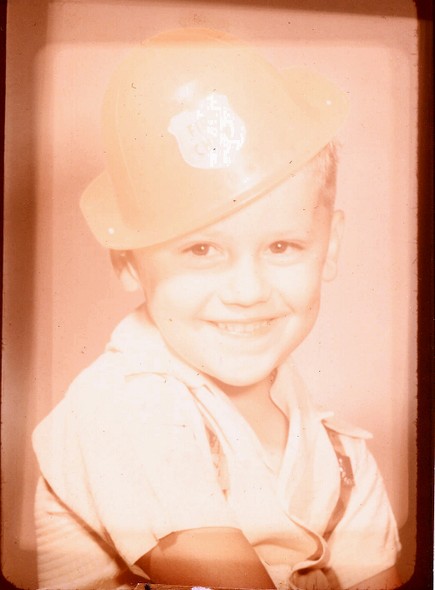
My dream as a five year old was to become a firefighter someday. I never lost that interest in wanting to help people. In fact, I still have it today although my time to serve as a firefighter is in the past.
I worked in public fire protection for 41 years including 24 years as a fire chief. I also worked in private fire protection for nine years. When I began my career, I was excited to be a firefighter, and I wasn't thinking about being anything else in the fire department.
I began my fire service career as an Auxiliary Firefighter (now called Reserve Firefighter) with the Bakersfield, California Fire Department in 1963. The Bakersfield Fire Department established a 160-member cadre of auxiliary firefighting personnel during World War II because many members of the Bakersfield Fire Department were needed for military service.
Up until I joined, there were no auxiliary firefighter members of the Bakersfield Fire Department younger than 40 years of age. The lower age limit was established to ensure that auxiliary firefighters would not be drafted into military service, and the age restriction remained in place until 1963 when I joined the Bakersfield Fire Department as an auxiliary firefighter.
We trained in individual groups of auxiliary firefighters and we trained with the regular firefighters. We responded to greater alarm fires, and we were eligible after completing prescribed training to work on engine or ladder companies and fill in as supplemental personnel in the fire stations. This activity with the Bakersfield Fire Department convinced me that I wanted to be a firefighter.
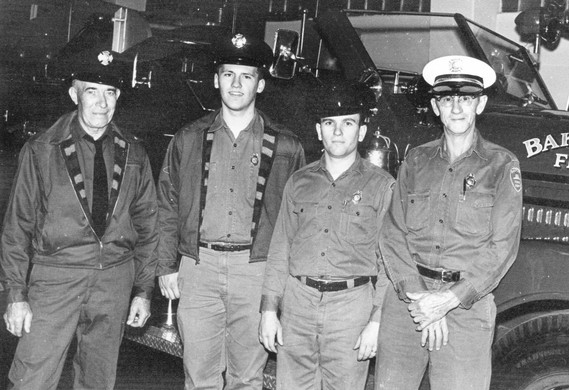
Here I am as an auxiliary firefighter for the City of Bakersfield. I'm the second person from the left. I was 16 years of age when this photo was taken. Can you imagine how happy I was to have become a firefighter while I was a high school junior? I served in this capacity for six years ... as an auxiliary firefighter - not as a high school junior. It helps to have a sense of humor if you want to survive and thrive as a firefighter.
Photographs can be strong reminders of both personal goals and personal achievements.
My Transition from Municipal Fire Protection to County-wide Fire Protection
In 1965, I began working as a Seasonal Firefighter for the Kern County Fire Department (KCFD) during summer months. I subsequently worked for the Fresno State College (now Cal State University Fresno) Fire Department during the school year. I took time out for military service and returned to the KCFD as a full-time firefighter.
There aren't words to describe all of the positive feelings and opportunities that I experienced when I was a member of the KCFD. I worked four fire seasons as a seasonal firefighter and one fire season as an "extra-help" (relief) firefighter. I then worked as a Firefighter, Fire Engineer and Fire Captain. In addition to emergency incident experience that my KCFD positions provided, I was fortunate to have served as a relief Captain in Battalion 4, station Captain (Station 72 - Lake Isabella - patrol, engine and wildland hand crew), Fire Prevention Captain, and as the Safety and Public Information Officer. I was an active member of the Kern County Firefighters Union, IAFF Local 1301 during my full-time employment with the KCFD.
All of the KCFD personnel that I knew and worked with were extremely pleasant, always professional and very proficient in their job duties. I always felt I was treated with respect, and I endeavored to be respectful towards everyone with whom I had contact.
The KCFD had more than 500 full-time firefighting personnel and approximately 250 call firefighters during my employment with the KCFD. I learned a lot about building teams, communicating among organizational members, evaluating and improving personal performance and productivity, as well as occupational safety.
I participated with after-dinner crew activities such as basketball or volleyball. I watched evening TV with the crews. I participated in general discussions. I did everything that I could to fit in with and enjoy being a member of the crews with which I worked while I was assigned to a fire station.
In addition to the above activities with the KCFD, I did something that has helped me throughout my entire career: I decided I would study at least one hour each day that I was on-duty in a fire station.
My study materials ranged from all of the books and publications in each fire station's departmental library to textbooks from the fire science classes that I was taking at Bakersfield College. I spent time studying the spiral-bound notebooks I used for recording information from my fire science classes. I wrote notes when I was reading the books and manuals in fire station libraries. Because each station library was provided the same materials, I didn't have to worry about materials being in one station but not in another.
My evening studies while on-duty meant that I sometimes was the last person to bed because I didn't want my studying to interfere with my time spent with my fellow firefighters. On occasion, I was the first person up so that I could study while others slept.
During my time with the KCFD, I had outstanding supervisors. They provided encouragement, guidance, recommendations and training in every facet that I could imagine. I was willing to listen to each of my peers and supervisors and reflect on what they shared with me. When I became a supervisor, I remembered the positive efforts that my supervisors used when they were helping me become a proficient firefighter, and I tried to emulate their positive influences on my career as I spoke with and worked with my subordinates.
Many of my initial fire department supervisors served in World War Two and/or the Korean War. They knew what could happen if crews weren't properly trained and supervised. They were mature and thoughtful leaders. I will forever be grateful to all of my supervisors and leaders that taught me more than one can imagine.
It's About You, Not About Me
There are two distinct reasons that I'm sharing my perspective on how you can study in order to be better at your present job and also prepare for what hopefully might be your next one.
First, if I can study, learn and do well on promotional tests, then you should be able to do well yourself - if you have a system to learn the facets of your job and prepare yourself over the course of your career. As one example, I learned the entire piping system on each fire engine to which I was assigned. I spent time on my back on a floor creeper under these fire engines and with a flashlight in one hand so that I could make diagrams of the pump and its associated piping.
I knew the inventory of each compartment on each apparatus to which I was assigned.
I learned the nozzle settings on the fog nozzles on the apparatus so that I could estimate the water flow from each pre-connected hose. I knew the tip sizes of the smooth bore nozzle sets on each apparatus.
I learned the characteristics of the nozzle on each master stream (monitor) appliance on top of each fire engine to which I was assigned.
In short, I wanted to learn everything that I could so I could become a skilled and proficient firefighter.
REMEMBER THIS:
If I can, YOU can.
Second, if you want to study, learn and do well on promotional tests and have corresponding knowledge, skills and abilities to enable you to be a proficient and prepared firefighter, then you need to avoid spending too much time on your fanny. This advice probably would serve you well as a school student or college student or in any other profession. If you are wondering what your fanny has to do with your acquiring knowledge, skills or abilities, I hope you will soon understand why I feel this way.
Recliners didn't exist in fire stations when I worked in fire stations. Sure, I've seen firefighters seated in a chair or on a fire station commercial-duty sofa fall asleep while watching TV or during a class. Just as the fire service is (rightly so) on a campaign to help firefighters minimize exposure to carcinogenic risks, I think the risks of recliners in fire stations should be noted and addressed throughout the fire service. I know for a fact that too many fire stations have personnel that feel that recliners are needed and beneficial.
I believe recliners promote fire service complacency, and they certainly aren't conducive to increasing one's accumulated knowledge. YouTube is a wonderful source of videos that have a high correlation between firefighters and how to handle emergencies, acquire new skills and other relevant topics, but I've seen firefighters fall asleep while watching YouTube or other videos. When we are asleep during a class, we can't learn. When we fall asleep while studying, we can't learn.
It's been my long-held and strong opinion that your being in a recliner isn't a proper way to conduct training or study to improve one's job skills, promotional chances or anything else. As a fire chief, I purchased a number of recliners for fire station crews. They are comfortable for relaxing. I have two in my home. I just don't believe they are suitable for studying or acquiring knowledge while in a fire station.
If you want to learn, you will be more likely to succeed if you aren't studying while seated in a recliner. Giggle all you want, but I'm convinced of their detrimental impacts upon learning.
This isn't a good way to learn.
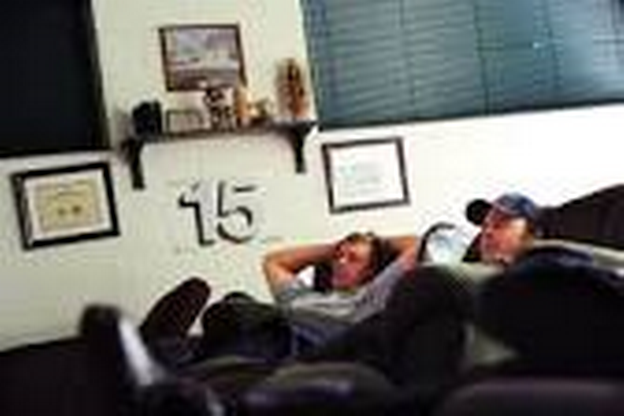
Nor is this.
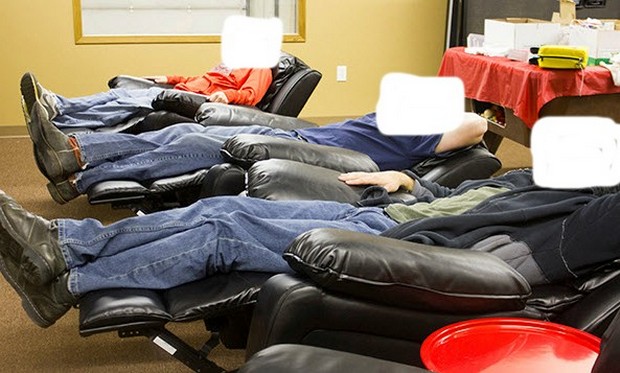
Nor is this.

Recliners should come with a manufacturer's tag that states they are intended for resting and relaxing - neither of which will boost a firefighter's knowledge nor the chances of knowing what to do or when to do it at an incident scene - and that they are not sold for the purpose of helping firefighters do their jobs more efficiently or enable them to build a solid knowledge base about the many facets of a firefighting and rescue career.
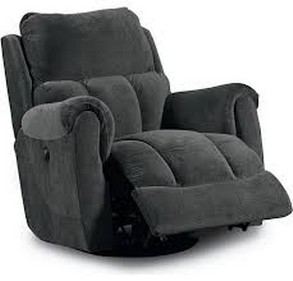
Disclaimer
I have no idea where, when or by whom these "recliner" photographs were taken. They have been floating around the internet for several years. Any resemblance to the recliners or personnel in your or another fire department is purely coincidental. However, if you have perfected a study technique that demonstrates that sitting on your backside in a comfortable recliner has helped you advance in your fire service career, I would like to hear from you.
I logged a lot of time at fire station kitchen tables studying. I studied even more at the kitchen table at my home. My study habits paid big dividends and noticeable financial rewards during my career.
Making Decisions That Were in My Family's Best Interests
I left the Kern County Fire Department at the end of 1978 to become the second of two Assistant Fire Chiefs in Chico, California. My decision to leave the KCFD was a difficult one, and I think it surprised everyone except my wife. It was made for family reasons, totally unrelated to the Kern County Fire Department or my desire to continue to serve as a member of the KCFD. As much as I would have enjoyed serving my entire career with the KCFD, my wife and I felt that our move to Chico was the right thing to do for our family. I've never regretted the move, but I missed working with my KCFD colleagues for the remainder of my career. My way of honoring my former colleagues in the Kern County Fire Department was to do my best to demonstrate the attributes that I acquired during my time with the KCFD.
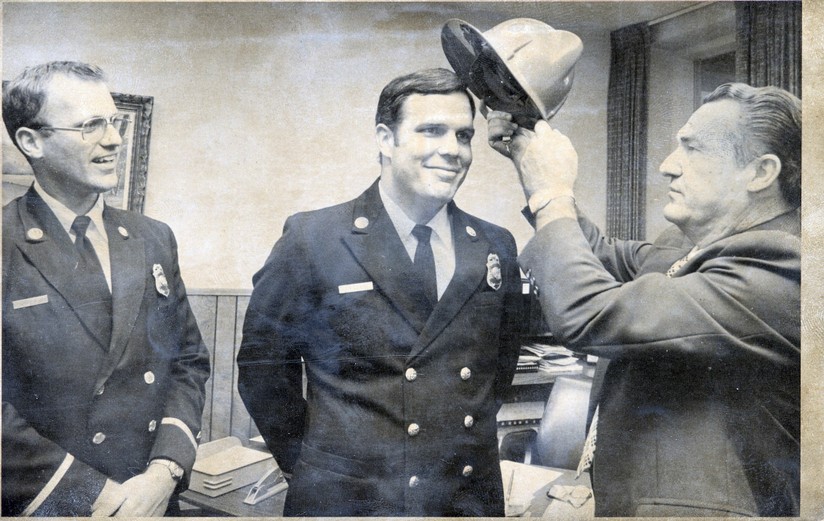
This photo shows KCFD Fire Chief Carl Williams presenting Captain Dan Clark with the Fire Information Officer helmet that I wore during my time as the KCFD's Safety and Public Information Officer. The Bakersfield Californian newspaper published this photo along with information regarding my leaving and introducing Captain Clark as my replacement. It's important to note that Captain Clark also served as an auxiliary firefighter for the Bakersfield Fire Department.
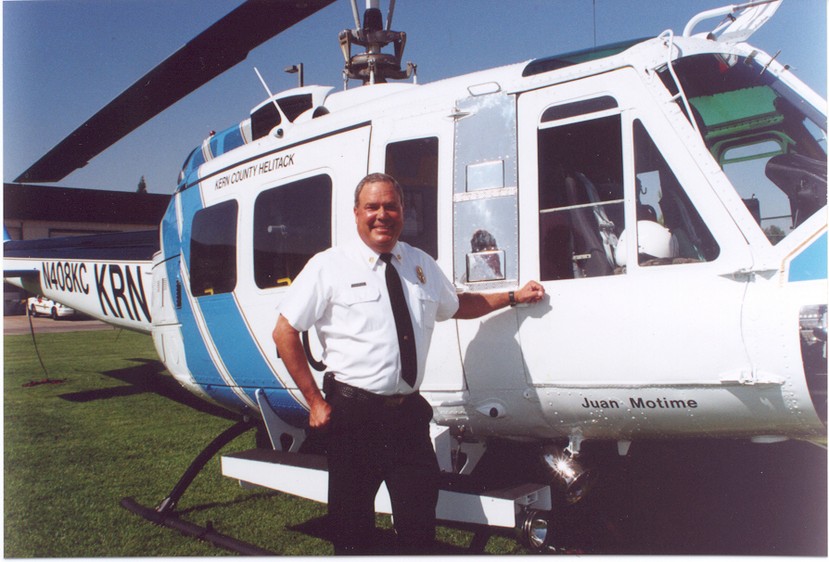
My long-time friend Captain Dan Clark continued his steady pursuit of more opportunities to help firefighters and the citizens of Kern County. He competed for and was promoted to Battalion Chief, Deputy Chief and then Chief of the Kern County Fire Department. I am proud of him as a friend and for being an effective and very progressive fire chief. Initiating the KCFD's helitack program was one of the many significant ways he helped lead the KCFD in protecting the public and its firefighters.
I never regretted my decision to leave the Kern County Fire Department and join the Chico Fire Department. However, just as most of us remain loyal to our hometowns and our high school alma maters, I have always appreciated that my roots were connected to the Bakersfield Fire Department and the Kern County Fire Department. These departments continue to be outstanding fire and rescue organizations, and I will always be thankful for the tremendous experiences that I had while a member of each of these fire departments.
Unexpected Opportunities
When my family and I moved to Chico, my wife and I thought in terms of my being an assistant fire chief. We had no discussions about "what if the fire chief ..." or "maybe someday ...."
I looked forward to my new job duties, and I liked the people with whom I was working.
I had no idea the fire chief that just hired me would resign and be gone thirty days after I began my new job in Chico. One week after I began my new job, the fire chief was given an unexpected opportunity to return to his "out of state" hometown as their fire chief. Rather than let uncertainty about my new boss leaving consume my thinking, I maintained my focus and assisted the interim fire chief as much as I could.
When the vacancy was announced formally and notice of applications being taken was circulated, I realized the interim Fire Chief - the senior Assistant Fire Chief - wasn't interested in applying for the job. The thought then came to mind that I had no idea who would be my next boss. I had a high regard for the personnel with whom I was working, and I decided to apply for the vacancy.
After the dust settled from the fire chief's departure and the competitive testing process used to fill the position was finished, I was selected to be the next Chico fire chief. Six months after having been appointed to the newly created position of the second assistant fire chief, I was the fire chief. That moment in my career was a pivotal one. Many people think of a career as a job that enables a person to work for one employer in one location for a long period of time. While that may be a suitable definition of a career for many people, it certainly doesn't describe my career or those of some other people that I know or have studied.
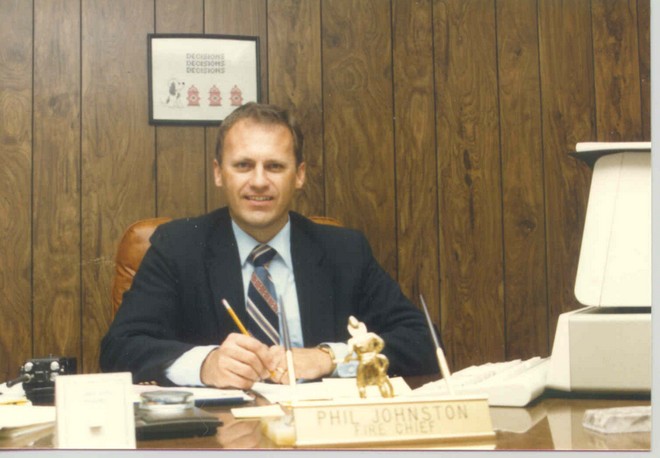
This photo shows me at my desk as the fire chief in Chico. Few people outside the fire department knew that I purchased the IBM PC computer for my own use. Trying to get funds for this to be a fire department expenditure would have not been fruitful. This was before the concept of microcomputers (as they were then called) on a desk was acceptable in my local work environment.
During my career, I served as the fire chief in five cities: Chico, California; Boise, Idaho; Springfield, Missouri; Little Rock, Arkansas, and Warrensburg, Missouri. I served as a fire chief for 24.8 years, 9,056 days. 217,344 hours. 13,040,640 minutes. It was a privilege being able to serve firefighters and the public for that period of time.
There have been many aspects to my career. Because of them, I acquired a broad background not only in fire protection and fire suppression but also in what I call "Life 101." Some people probably wouldn't enjoy moving and all of the challenges that we faced each time we moved. Moves bring new adventures for families. Moves enable us to make new friends, learn new communities and experience the beauty of new scenery and different climates. No two cities have identical fire protection needs.
Relocation requires resiliency. It's impossible to make a successful move without being personally and professionally committed to doing ones very best.
Giving Thanks Where Thanks Are Due
I learned a lot about many things during my entire career. It was never my plan to move from one city to another, but my family and I were certainly blessed by the succession of moves. To God, we give thanks for directing us on the path that we took. It brought us closer together and taught us that God really helps people grow through challenges, that He meets our needs every single day, and that He expects each of us to be a servant to those around us that are in need.
I used to joke with friends that my family had become nomadic or gypsy-oriented. It was sometimes easier to make those comments than to explain how prayer opened doors where my family could serve God more or better or both. As time passed, I realized ways that I could share my faith in Christ and not become concerned that I would be offending people. Everyone has spiritual needs, and I can generally share my spiritual needs and how I am addressing them without being offensive to others.
From the beginning of my first day as a firefighter until my last minute of my final day as a fire chief, I always thought of my positions and experiences as blessings from God. I saw them as tremendous opportunities to be a servant. My responsibilities with regard to budget preparation and administration provided me with opportunities to show that our fire departments were good stewards of the public's monies. It was never easy being a fire chief, but it often was rewarding in a heartfelt way. The sense of teamwork that an efficient fire department exudes is difficult to explain to someone who has never been a firefighter or been a member of a cohesive team.
To this day, I am thankful for the many opportunities that I was given to help people during my career. I enjoyed helping firefighters as much as helping community members or anyone else. My gratitude to those that helped me establish and nurture my career are no longer with us. The best tribute I can give to them is to share my knowledge, skills and ability with others that are wanting to become firefighters or enhance their fire service careers.
From Bugs to Bombers: Things With Wings
I have always had a fascination with things that fly. Bugs. Birds. Airplanes. Helicopters. Gliders. Balloons. Single-engine aircraft. Multi-engine jets. I have always enjoyed watching aircraft and the people that operate and maintain them. When I was a youngster, my parents sometimes took our family on Sunday afternoons to the Kern County Airport (now known as Meadows Field or KBFL) in Northwest Bakersfield. We would watch airplanes landing and departing. I didn't know much about the aircraft, but I certainly enjoyed watching them and listening to their sounds.
When I, as a new firefighter, learned that aircraft were often used in California's hot summers to drop fire retardant on wildfires, my fascination with aircraft jumped up several notches. An unanticipated benefit of my assignments as a fire chief was that I frequently worked and lived near military, government, firefighting and civil aviation facilities.
I enjoyed the chances I had to interact and work with personnel from Cal Fire's Chico Air Attack Base, Boise's Gowen Field (Idaho Air National Guard fighter base and Boise NF air tanker base), Springfield's Army National Guard Aviation Classification Repair Activity Depot (helicopter facility), Little Rock Air Force Base (C-130 base), and Whiteman Air Force Base (B-2 bomber facility near Warrensburg MO).
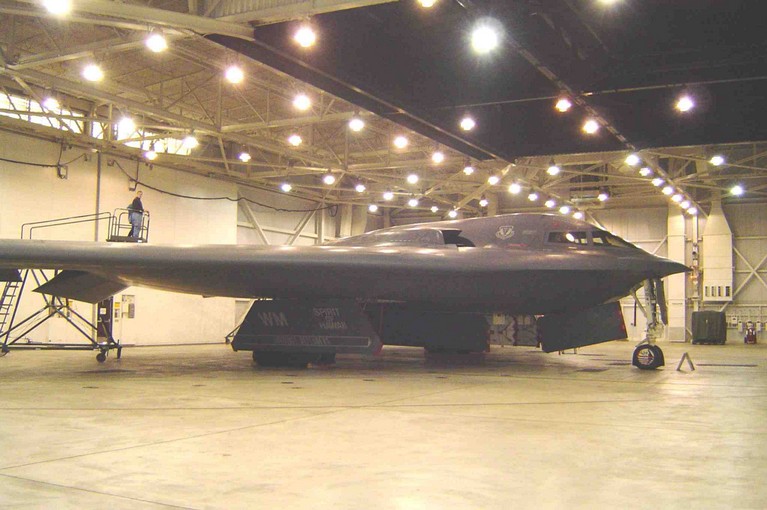
I had many opportunities to see aircraft up close. This B-2 bomber is stationed at Whiteman AFB, Missouri. I don't know the identity of the people on the platform. The USAF did not allow civilians or outside agency personnel to see the rear of the B-2 aircraft. I never asked why.
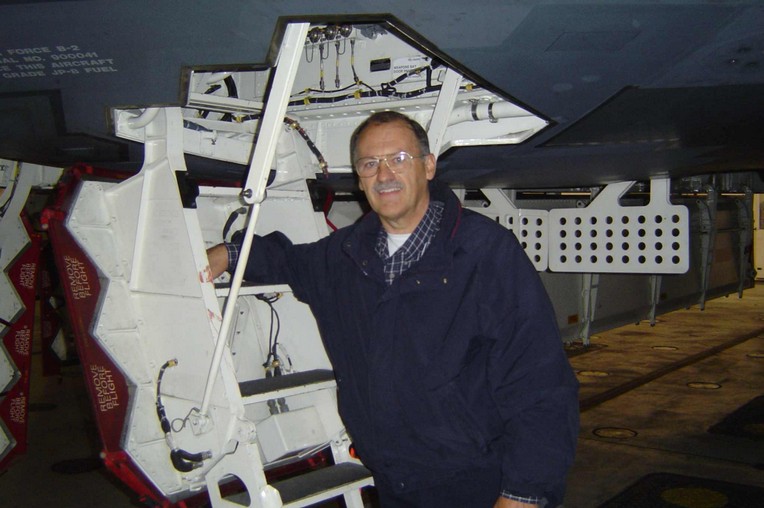
I had the privilege of going inside the B-2 bomber.
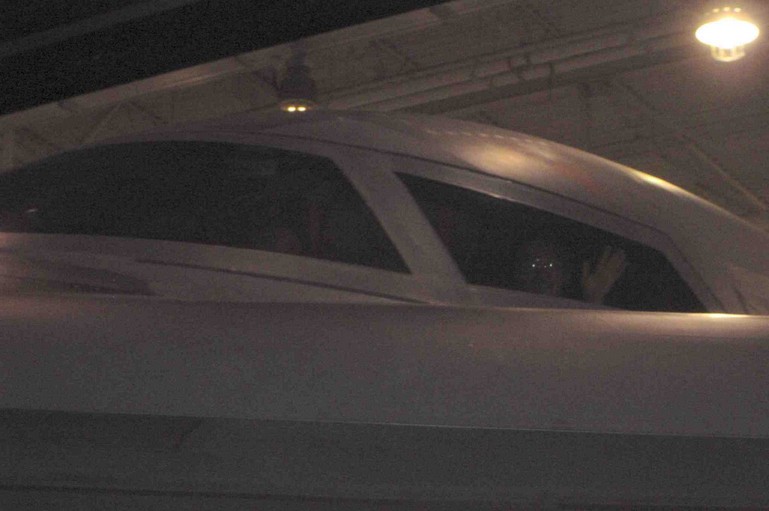
Can you see me waving inside the cockpit? This was a real thrill for me.
Part of my career training involved knowing how to respond to military aircraft incidents. While all aircraft incidents have the potential to pose tremendous challenges to emergency responders, none of the aircraft with which I received training and familiarization were as challenging as learning the fire and rescue intricacies of the B-2 bomber. The Whiteman Air Force Base Fire and Emergency Services team members were very personable, well-prepared and highly skilled. They provided excellent training to area response agency personnel.
I acquired considerable experience working at and with the airports protected by fire departments that I supervised during my career. I developed a working familiarity with Federal Aviation Regulations, Advisory Circulars and NFPA Standards applicable to Indexed Airports. An airport's index is the indicator that determines whether or not an airport needs staffed aircraft rescue fire fighting (ARFF) capabilities for scheduled flights of airline passenger aircraft. I also became familiar with FAA, NFPA and UFC (now ICC Fire Code) regulations applicable to airport operations.
I have not personally explored the use of drones in the fire service. However, I am absolutely convinced they represent a number of new dimensions for emergency services applications. Aerial views of incident scenes can be invaluable. Searching for missing persons by use of drones can provide aerial insight that otherwise would require a helicopter or slow-moving airplane. Surveying levees during flooding. Looking for footprints in snow. The list goes on and on.
My aviation interests helped me many times during my career. I saw the same types of benefits when I talked and worked with firefighters assigned to water rescue teams. Many of them were SCUBA divers or boating enthusiasts. I worked with a multitude of firefighters that had mechanical or industrial interests before they became firefighters. The point I'm making here is that the fire service is a career where members have opportunities to interact in one way or another with people from all walks of life.
We, as firefighters, are responsible for protecting everyone within our fire departments' service areas. Firefighters that bring special areas of interest and knowledge to the fire department are frequently able to use that knowledge to increase their usefulness as firefighters when emergencies occur.
I share this aircraft information for two reasons: 1) Being a firefighter is an exciting career that enables us to "rub elbows" with almost every aspect of our communities. My being able to learn about the aircraft I helped protect was personally and professionally rewarding, and 2) The people responsible for the care, maintaintenance and operation of the aircraft were highly skilled and very personable - making them ideally suited to explaining aircraft systems and overall characteristics to me and my colleagues. The fact that I enjoyed "things" that fly added to my enjoyment of being able to interact with aircraft folks and learn about their aircraft.
Building and Bolstering Teams
Being a fire chief enabled me to work towards building teams that would provide better, more efficient and less costly services in response to public needs and requests. I enjoyed being tasked with identifying obstacles, alleviating challenges and finding alternatives that provided effective and efficient fire departments. I enjoyed sharing my ideas, methods and thoughts with those that would listen.
I worked with thousands of outstanding people and firefighters during the course of my career. I participated in the testing, selection, employment, promotion, career guidance and training of a large number of firefighters. From the newest rookie to the fire chief, each of us is (or was) a firefighter. Those who advanced in their careers but failed to remember what it was like to be a rookie or probationary firefighter or any of the intermediate positions between being new and being the fire chief often struggled to understand the challenges their subordinates faced on particular issues.
Vegetation Fires
For the first twenty-five years of my career, I worked near or within what today is commonly known as the "Wildland - Urban Interface." The "WUI" - as it's frequently written - is the expanse of land that enables native vegetation to be in very close proximity to homes and businesses. As I write these words, the Town of Paradise, California, has just been devoured by the Camp Fire (November 8, 2018).
As the climate changes, I believe mega-fires with "blow-torch" wind-propelled aspects will increase in frequency and severity. When I began my career in 1963, a 500-acre wildfire was an "attention getter" in California. Ten years later, a 5,000-acre wildfire was a big deal, and a 25,000-acre wildfire was a really big deal. With few exceptions like the 1961 BelAire fire in Southern California, the 1980 Panorama Fire in Southern California or the 1991 East Bay Hills Fire in Berkeley and Oakland, losses of large numbers of dwellings were relatively rare even with the large wildfires that occurred during the first half of my career.
Today, many firefighters are becoming accustomed to monstrously large mega-fires that burn 50,000 acres, 100,000 acres, 200,000 acres or more. What more can I say? Is it too late to avert year-round destructive wildfires somewhere in the United State?
The Importance of Understanding Governmental Budgeting
My employment as a fire chief provided me with significant opportunities to work on and submit the documentation and justifications needed for 25 annual fire department budgets. That is a lot of number crunching, a lot of written and verbal explanations of the need for requested additives to the budget, and in some cases justifications why reductions in the budget should not be made.
Fire chiefs that successfully defer or eliminate budget reductions don't often receive the high-fives and intra-department accolades, but holding on to what a fire department has - especially in terms of personnel - is becoming a bigger and bigger challenge every year.
Before I became a fire chief, I learned a budget is a financial forecast of the future. With that knowledge, I used my budget skills to 1) enable me to adapt to my employer's budget guidelines and policies, 2) ensure our fire department budget requests were consistent with verifiable and priority department needs, 3) seek funding that was consistent with our mission to protect our community, and 4) remind fire department members that the city's leaders were tasked with producing an annual budget that was balanced and took into account the needs of every city department, agency and commission.
Municipal budgeting is comparable to the two parents of twelve kids trying to make sure that each child receives a balanced dinner with fair portions of each food item. It may seem easy, but it's often a very big challenge. City councils, mayors, city managers and city administrators have the same responsibilities as those two parents feeding their children: meet the needs, budget fairly and make sure that portions are adequate.
As this web site evolves, I will share administrative and fiscal tips, tricks and traps to help you improve your budget preparation skills and to enable you to demonstrate that the public's trust in your fire department's ability to wisely expend taxpayers' money has been justly placed.
My motivation to be an elementary school volunteer is related to my awareness that students that don't know how to multiply, divide or subtract numbers are unlikely to have successful fire service careers. I can't help every elementary school student, but I can help those with whom I have contact. I have worked with firefighters that struggled with reading, writing and math. Forty or fifty years ago, people might succeed and obtain a firefighters job without having reading, writing and math skills. That is nearly impossible today. Accordingly, I try to help students improve their educations, knowing that most or all will need them in order to acquire jobs someday.
Forever Thankful For Something That Didn't Happen
With one exception, I can't think of anything about a fire department to which I didn't have personal contact or personal exposure. That one exception is this, and it is the achievement for which I am most grateful: At no time during my fire chief career was it necessary for me or our fire department to deal with our own Line-of-Duty Death (LODD) experiences.
I will forever be thankful that our firefighters, their families and our communities did not have to deal with this terrible experience. I have lost count of the numbers of fire fighters, police officers, sheriff's deputies, EMTs, paramedics and state troopers whose duty-related funerals or memorial services I knew about or attended during my career. These are unforgettable experiences for everyone involved. I have listened to or watched an inestimable number of fire chiefs, police chiefs, sheriffs, state patrol leaders, EMS agency directors and other public safety leaders on news broadcasts where they were talking about a member (or several members of their agency) whose life was just lost in the line of duty.
To me, praying daily for our firefighters and their families was an investment in their lives. Praying for our crews while they were working on fire or rescue incidents was worthwhile. Asking our chaplains to pray for personnel struggling with personal objectives, marriage challenges, substance abuse problems, financial difficulties and a myriad of other things helped our fire department personnel avoid our own Line-of-Duty Death experiences. Prayer wasn't exclusively for fire department personnel. Prayer and other forms of support were made on behalf of the public, the victims of fires, accidents and incidents, and their family members.
Our having reasonable and workable drug and alcohol policies and random testing providing us with improved chances of avoiding our own Line-of-Duty Death experiences. I never met a firefighter - or anyone else, for that matter - that wanted to get hooked on drugs. I have seen successful U-turns made by firefighters and others that developed substance abuse problems, and I will forever be an advocate for wanting to help people get away and stay away from illegitimate drugs or excessive consumption of alcoholic beverages.
Our never-ending and forever-evolving training programs, and our solid support from city councils, mayors and city managers contributed greatly to avoiding a Line-of-Duty Death.
The support from our citizens through their compliance with our public education campaigns, our weed abatement programs as well as our life-safety and fire-safety programs helped reduce the risk of Line-of-Duty Deaths to our firefighters.
Comprehensive emergency vehicle operator training programs and firefighter compliance with laws, policies and procedures helped us avoid having a Line-of-Duty Death from a motor vehicle collision.
Firefighters live with the daily reality that death and injury are possible. My philosophy is that one's chances of surviving a firefighting career and retiring someday are greatly increased by boosting one's knowledge, skills, abilities and safety awareness. Training, education and accepting personal responsibility for helping myself and those around me are important factors in helping avoid death or injury when on the job.
Feeding and Nurturing the "Fire Department - Fire Union" Relationship
I had many very positive experiences working with officers and members of the International Association of Fire Fighters (IAFF) local unions during my career as a fire chief. When I was a member of the Kern County Fire Department, I was a member of IAFF Local Union 1301. It was an extremely enjoyable experience. I learned from my first year as a full-time firefighter that the working and trust relationships between the union president and the fire chief were among the most important relationships that could exist within a "unionized" fire department. In many ways, that relationship seemed to me to be similar to the relationship between the parents of a two-parent household.
Firefighters seemed to closely watch the "president - chief" relationship to see if the individual reactions and/or responses were in agreement with the other's reactions and/or responses. My time as a member of IAFF Local Union 1301 taught me a great deal about how a fire chief and union president should and could interact, and I relied on these observations many times throughout my service as a fire chief.
I am convinced that a "trust relationship" needs to first be created before a fire chief and a union president can expect to build an effective working relationship. The precursor to building that relationship is the establishment of a two-person relationship where open and frequent communications between the chief and the president occurs.The more these two individuals talk and interact, the more likely they are to be able to express their concerns to each other. If both of them are always grousing and griping to the other about this, that or the other thing, the chances of building an effective relationship are likely to quickly vanish. On the other hand, if the two of them can establish a communications process based upon the trust relationship, there really isn't a limit to the mutually beneficial aspects that can accrue for the firefighters, the city and the community.
Today, there are labor-management initiatives through the International Association of Fire Chiefs and the International Association of Fire Fighters that provide fire chiefs and union leaders with skills, tools and training that should enable them to form effective working relationships with each other. There are many other programs available that help build or strengthen the bonds between a fire department's leadership team and the leaders of a local fire union.
I would rather be the chief of a fire department whose members are affiliated with the IAFF than to be the chief of a fire department whose members did not have the cohesive and cooperative "glue" that helps them work as a team. Again, I will explain further as this web site evolves. I realize that some mayors, council members, city administrators, city managers and fire chiefs may strongly disagree with me on this point. However, I had far more positive experiences and observed substantially more positive outcomes for the citizens and the firefighters when there was a high level of mutual trust, a deep degree of mutual respect, and regular communications between the firefighters' union and the city and fire department leaders.
Private Fire Protection Experiences
I worked nine years in private fire protection as a fire investigator and as a fire protection consultant. The first break in my fire department service was for a period of almost two years, and the second break was for a period of seven years. I provided these private fire protection services in California, Iowa, Kentucky, Missouri and Oklahoma.
I developed skills and acquired experience as an independent fire investigator covering large geographical areas that wouldn't have been possible while working for a fire department. My work in this area was much more involved than the work I did when I was investigating fires as a member of a fire department. I worked with utility companies, law firms, business owners and insurance companies. As a fire protection consultant, I had opportunities to provide recommendations and solutions to clients that wanted answers to questions or wanted choices (aka options) for fire protection problems.
As a fire investigator, I provided fire and explosion investigations and provided written reports that substantiated the evidence, information and methodologies used to determine the origins and causes of fires and explosions. I wasn't hesitant to categorize a fire's cause as 'undetermined' when there was no or insufficient evidence to support a determination as to the cause of a fire.
The opportunities to work in the private-sector actually provided me with more opportunities to be with my family. As a private-sector fire investigator and fire consultant, I had greater latitude to schedule my work hours to enable me to spend time with my wife and children. As any firefighter will tell you, folks that work for fire departments sometimes have little or no control over their scheduled work hours.
As a fire chief, the only practical way I had to get a genuine break from my job was to leave town. This was okay if my wife, children and I wanted to travel somewhere. However, I sometimes just wanted to work on a project at home or build something or take a class - but the possibility of an interruption was ever present if I were at home or nearby. I successfully used these two "interludes" in my fire chief career to give me what I called "modified sabbatical leaves of sorts."
Working in private fire protection and having the ability to adjust my work schedule gave me the opportunity to learn about microcomputers and software. I had opportunities to teach about various topics at regional schools and training programs. I provided fire pattern and fire investigation training to private sector clients. I also wrote about the introduction of microcomputers and software into the fire service, and I learned how to use "off-the-shelf" commercial software to manage fire department budget accounts and track revenues and expenditures.
REMEMBER THIS:
If I can, YOU can.
Exploring This Web Site
The easiest way to grasp what is accessible here is by exploring the menu. Menu listings that currently don't connect to a valid link have been temporarily hidden. As I add new material throughout the menu structure, the listings will populate the menu. Hopefully, if you can see it on the menu, you will be able to view it.
If you are asked for a password to open a ZIPped file that you downloaded here, please remember the password is: firefaqs.com ... no www ... only: firefaqs.com !!! I don't intend to password-protect every downloadable file, but there will be some that will require use of the firefaqs.com password to open a ZIPped file. I use the ZIP format to reduce the size of the files.
Summary
I hope you enjoy your visits to this site. If you have a dream, I hope you pursue it. If you don't have a dream, perhaps you need one. Dreams can be powerful motivators.
Sincerely,
Phil Johnston